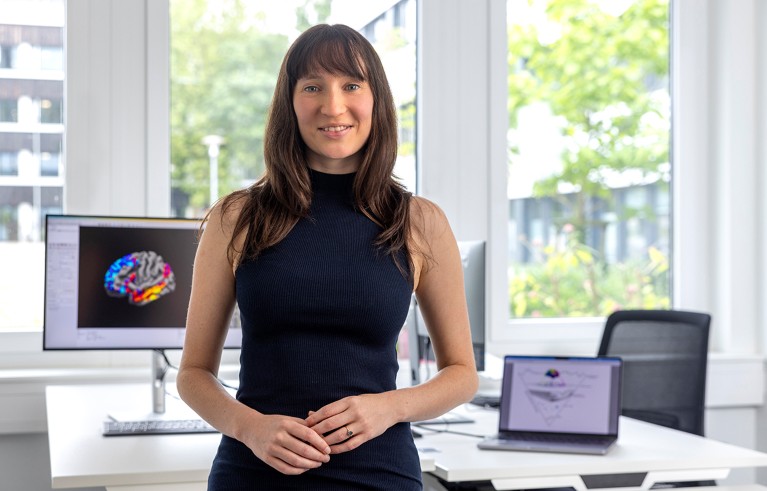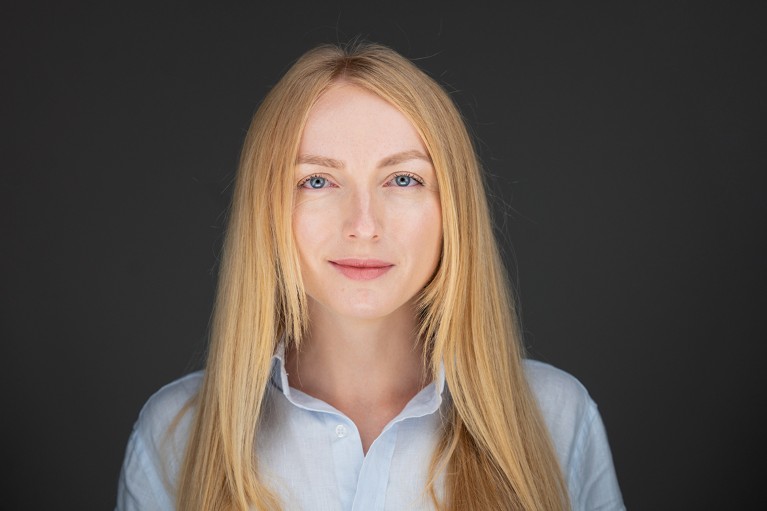Three of the most prolific young researchers in neuroscience-related output in the Nature Index discuss the problems they’re trying to solve and what keeps them optimistic about their work.
CASEY PAQUOLA: Mind modeller

Casey Paquola is building a model that simulates brain changes from infancy to adulthood so researchers can track disease progression.Credit: Forschungszentrum Jülich/Sascha Kreklau
Roughly 75% of severe psychiatric disorders emerge before the age of 24, so “intervention in youth is likely to have the most significant impact in long-term psychiatric health”, says Casey Paquola, a computational neuroscientist at the Jülich Research Centre, one of the largest institutions in the Helmholtz Association of German Research Centres, Germany’s leading research organization.
Paquola and her colleagues are using large data sets of infant, child and adolescent brain scans to inform a new model that simulates changes from infancy to adulthood in the hope that it can predict the development of conditions such as schizophrenia and psychosis.
Nature Index 2024 Neuroscience
“What makes our approach unique, but also effective, is that we do this in a multiscale way,” says Paquola, referring to how the model accounts for changes at a cellular and DNA level, as well as larger shifts in the brain’s wiring and function. “That means we can cross-validate our theories for how cognition emerges.” Paquola received a €1.5-million (US$1.74-million) grant from the German Research Foundation, the country’s largest research funding organization, to support the work.
The model could inform future diagnosis and treatment protocols by allowing researchers to ‘reverse time’ and simulate the development of certain conditions backwards to find the cause. It could also help researchers to identify risk factors. In young children, for example, the brain’s cerebral cortex increases in thickness until adolescence, at which point it starts to thin back down again. Paquola and her colleagues observed unusually thick cortices in children with higher genetic risk of schizophrenia, which she says could be a symptom, or a cause, of the disease. “That’s the type of trajectory we’re interested in mapping,” she says.
Since moving to the town of Jülich in Germany from her native Australia, Paquola says she’s experienced strong support as an early career researcher. “It’s very hard for early career researchers to get a step up in Australia, I find. Whereas in Germany, they really do support younger researchers.”
For one thing, it is easier to acquire funding to support an entire research team for a multi-year project in Germany than it is in Australia, says Paquola. She adds that the local government in Jülich covers the primary costs of pre-school childcare for all residents, which is helping her plan her return to work after the birth of her son.
“It means I’ve been able to choose when to return to work based on what suits our family best,” she says. — Felicity Nelson
SOLOMIIA BOYKO: Alzheimer’s protein puzzler

Solomiia Boyko.Credit: Nancy Andrews
At Case Western Reserve University in Cleveland, Ohio, neuroscientist Solomiia Boyko is investigating how a type of brain protein called tau clumps inside the neurons of people with Alzheimer’s disease. Forming sticky, string-line accumulations called neurofibrillary tangles, this build-up blocks the synaptic lines of communication between neurons, which leads to the neuron cell death that drives dementia.
Past studies1 have shown that when droplets of tau protein are placed in a liquid, they will spontaneously gather around each other. Boyko wants to know if this dynamic holds true in living organisms or cells. “We know that [tau] droplets become aggregates,” says Boyko. “The missing part of the puzzle is whether this happens in the cell.”
The problem is that current tools and techniques are not advanced enough to show what happens to tau proteins within the swirling complexity of a living cell. So, Boyko and her colleagues created a liquid that chemically resembles a cell’s cytoplasm, the thick liquid that fills the inside of a cell, and watched what happened when they added tau droplets. Publishing their results in 2022, they describe behaviours similar to when oil comes into contact with water2. “They don’t mix,” says Boyko. “The tau form droplets and aggregate to each other.” What’s unclear is whether the process of tau droplets becoming tau aggregates have any physiological function in healthy brains, or if it is purely pathological.
As the global life expectancy improves, the number of people with Alzheimer’s, a disease that is strongly associated with ageing, will inevitably grow. From 1990 to 2019, the worldwide incidence of the disease ballooned by close to 150%. Researchers are struggling to keep pace — the Alzheimer’s drug-development pipeline for 2024 features fewer trials and fewer new drug candidates, compared with 2023.
There are methods in development that would allow in vivo observations of tau droplets, which Boyko is hopeful about. She says she is optimistic that the full biology of Alzheimer’s disease will eventually be decoded. “Alzheimer’s is such a big problem for the sufferers, the caregivers and the family. As a researcher, maybe I can be of some help,” she says. “I truly believe that the incremental changes of knowledge from research can make a difference.” — Benjamin Plackett
NICHOLAS BUSH: Neuron recorder

Nicholas Bush.Credit: Nicholas Edward Bush
As a first-year graduate student at Northwestern University in Evanston, Illinois, Nicholas Bush listened as researchers played the activity of a monkey’s sensory cortex — part of the brain that processes auditory, visual and other sensations — over a loudspeaker. When the monkey’s arm moved, he recalls hearing a ‘whoosh’ of electrical activity. At that moment, Bush knew he wanted to pursue a career in neuroscience. “To actually hear neurons in the brain of this monkey that was sitting right next to me, as it was actively moving, was just an ineffable moment,” he says.
Today, Bush is a postdoctoral fellow at the Seattle Children’s Research Institute in Washington, where he studies the circuits in the brainstem that control the ability to breathe. In a study3 published earlier this year, Bush and his colleagues showed how breathing disruptions associated with certain diseases can change the function of neurons in the brainstem that control breathing.
New implantable technologies can be invaluable for this kind of research, says Bush. He and his colleagues implanted silicon probes called Neuropixels, produced by Belgium-based non-profit research and development organization, Interuniversity Microelectronics Centre, into the skulls of mice to measure their neural activity at different points in the breathing cycle. When the mice were breathing normally, their neurons fired in a rhythmic cascade that reset each time they breathed out. Mice that were given morphine — an opioid drug that can cause breathing problems if misused — experienced a similar cycle of neuronal activity, but the wave of electrical activity from neuron to neuron was slower.
“Opioids are a huge concern right now,” says Bush, noting the millions of people around the world who are dealing with opioid-use disorder. “Knowing that [opioid use] is slowing down, or sort of restructuring, the dynamics of this system is particularly important.”
The team also measured how the neurons in the brainstem responded when mice were deprived of oxygen. When the mice gasped, their neurons stopped operating in a rhythmic pattern and instead fired all at once, facilitating a potentially life-saving increase in gas exchange. It’s hoped that such insights could inform research on sudden unexpected infant death syndrome in humans, which is thought to occur when infants experience a lack of oxygen but don’t wake up.
Technological advances such as Neuropixels are opening up many opportunities in neuroscience, says Bush. “The tools that are being developed are just astounding and are giving us new avenues of thinking about old problems,” he says. “It’s a super exciting time to be a neuroscientist.” — Felicity Nelson



